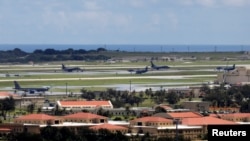The U.S. plans to dramatically improve the missile defense system on the island of Guam, its territory closest to China, a move urgently needed amid evolving missile and hypersonic weapon threats from Beijing, analysts say.
The head of the U.S. Missile Defense Agency, U.S. Navy Vice Admiral Jon Hill, said the first ballistic missile defense system was deployed more than 20 years ago, and “a modernization of a system that can defend the homeland is key going forward,” in an interview with Defense News earlier this month.
Guam faces an "evolved threat," as Hill put it, especially from China, in the form of increasingly advanced ballistic and cruise missiles, as well as new hypersonic weapons and even potential threats from space, which could strike simultaneously from multiple different vectors.
Experts told VOA Mandarin that installing new air and missile defense capabilities on the island is part of a broader effort to deter China across the Asia-Pacific region.
“Guam would be crucially important in a Taiwan contingency,” Denny Roy, a senior fellow at the East-West Center who focuses on Asia Pacific security issues, told VOA Mandarin in an emailed response. “It is close enough to anticipated flashpoints to be highly useful as a logistics hub, but far enough that some Chinese weapons systems would have difficulty striking it.”
Tensions between the U.S. and China escalated in August following House Speaker Nancy Pelosi’s visit to Taiwan. China has stepped up military exercises around the self-ruled island, and Beijing is reported to have stationed next-generation submarines across the waters facing Taiwan.
Guam, the westernmost territory of the United States, prides itself on being "where America's day begins." It’s much closer to Asia than the U.S.; it’s about 11,600 kilometers from the continental U.S., but only 2,700 kilometers away from Taiwan and 4,751 kilometers from China.
After World War II, Guam became one of the most important naval and air force bases for the U.S. in the Pacific region, which consists of the islands of Japan stretching to Guam and the islands of Micronesia.
Malcolm Davis, a senior analyst at Australian Strategic Policy Institute, a think tank in the capital city of Canberra, told VOA Mandarin that Guam is a key target for potential People’s Liberation Army (PLA) ballistic and cruise missile attacks because it has “a lot of military hardware concentrated in a small region — a ‘target-rich environment.’”
Davis said there are signs that China will annex Taiwan with force, possibility in the next decade. If the U.S. fails to protect Guam as a functioning forward base, defending Taiwan would become more difficult for Washington, and it would make Beijing’s annexation of Taiwan more likely, he said.
Hours after VOA Mandarin published this report in Chinese, China’s state-backed media Global Times said in an editorial on Wednesday that if the U.S. military intervenes in Taiwan affairs by force, “U.S. military bases, including Guam, are naturally within the PLA's firepower range.”
The Global Times report said U.S. agencies “including the Pentagon, FBI and CIA are masters at fabricating ‘China horror stories,’” with the goal of getting Congressional approval for bigger budgets.
“The U.S. military's remaking and upgrading of Guam can be considered ‘spiritual comfort’ at best. If Washington wants to truly resolve its inner unease, there is actually only one way: to completely dispel the idea of provoking China, and not to regard Guam as a ‘new front line against China,’ stated the Global Times piece.
Blake Herzinger, a nonresident Pacific Forum fellow, told VOA Mandarin in a phone interview that China could launch its Dong Feng-26 (DF-26) ballistic missile with a 4,000-kilometer range capable of striking Guam. Labeled by Chinese media as “the Guam Killer,” DF-26 features a modular design, allowing quick swaps between nuclear and conventional warheads.
“With that missile, the U.S. would have no way of knowing whether it’s a nuclear missile or not,” Herzinger told VOA Mandarin. “That opens the door for a potential nuclear escalation, which is a scary prospect.”
The 2023 U.S. defense budget calls for $892 million to build a ship-based Aegis Ballistic Missile Defense System to defend Guam. The Pentagon announced last month it would finish the project by 2028, yet Roy said that would be too late.
“The vulnerability of Guam, and the problem this would create for U.S. forces in the region, has been well known for at least a decade, but the U.S. government has only started taking serious action in the last year or so,” he told VOA Mandarin.
Roy continued to say the U.S. plan to complete a more capable new defense system by 2028 “doesn’t align with Adm. Davidson’s warning that China will attack Taiwan by 2027.” Former commander of the U.S. Indo-Pacific Command, Adm. Philip Davidson, warned in 2021 that China will launch a military attack against Taiwan in the next six years.
Herzinger pointed out that besides more advanced missile systems, the U.S. should also invest in cheaper, easier measures on Guam, such as building effective concrete aircraft shelters and investing in the next generation capability of the airfield.
“Far beyond its value as a strategic outpost, most importantly, Guam is American territory. So, people living in Guam are as deserving of protection against aggression as any other American citizens in our country,” he said, “I think that’s the most healthy way to look at this.”









